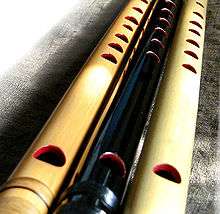Shinobue

7-hole Uta-you Shinobue in B-flat ("6-hon choshi") top binding
7-hole Uta-you Shinobue in B ("7-hon choshi") black painted
7-hole Uta-you Shinobue in C ("8-hon choshi") without binding
The shinobue (kanji: 篠笛; also called takebue (kanji: 竹笛)) in the context of Japanese traditional arts) is a Japanese transverse flute or fue that has a high-pitched sound. It is found in hayashi and nagauta ensembles, and plays important roles in noh and kabuki theatre music. It is heard in Shinto music such as kagura-den and in traditional Japanese folk songs. There are two styles: uta (song) and hayashi (festival). The uta is properly tuned to the Western scale, and can be played in ensembles or as a solo instrument. The hayashi is not in the correct pitch, because it is simply a piece of hollow bamboo with holes cut into it. It emits a very high-pitched sound, and is appropriate for the festival/folk music of Japan. Both shinobue flutes play a very important role in the Japanese theater.
See also
External links
- Kotos and More (Shinobue and other Japanese instruments with sound samples)
- Ron Korb's Asian Flute Gallery (features description and drawing of the Shinobue and other Japanese flutes)
- Syoji Yamaguchi's web site on Japanese transverse flutes (features articles on making and playing of the Shinobue and other Japanese transverse flutes: yokobue or fue)
- Japanese Traditional Music
| ||||||||||||||||||||||||||||||||||||||||||||||||||
|